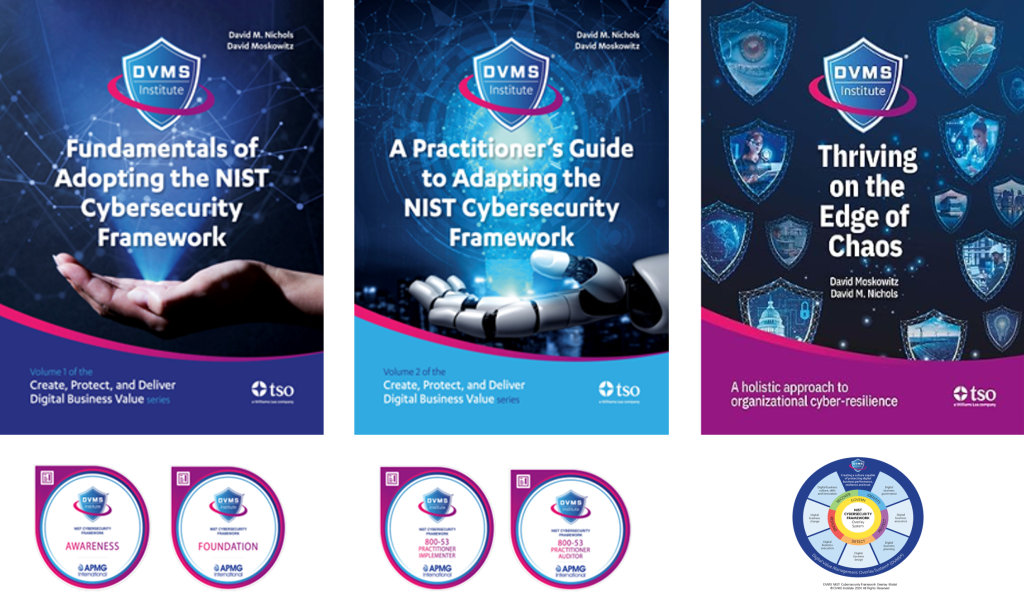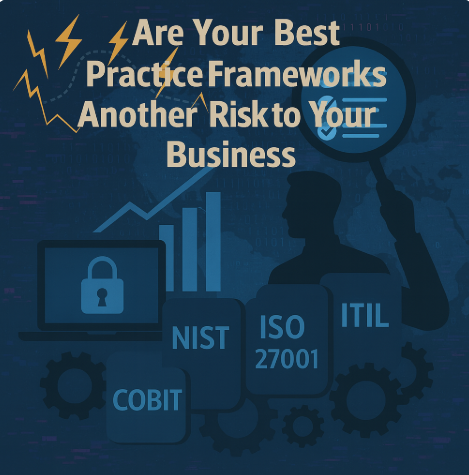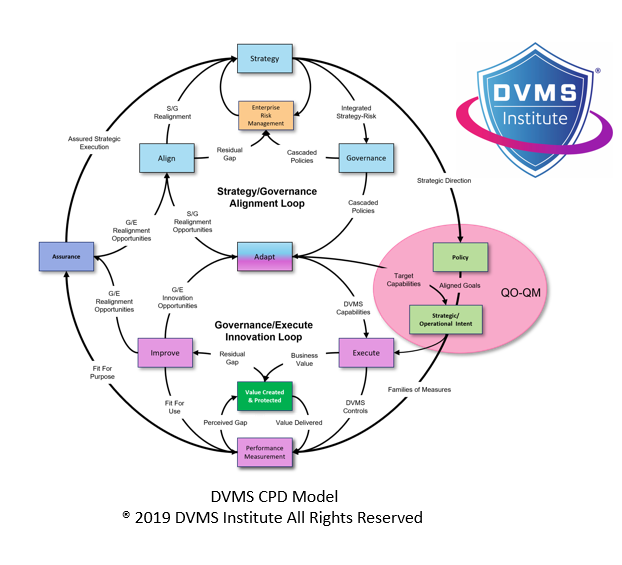Why Organizations Must Continually Assess Best Practice Frameworks to Ensure They Are Delivering Intended Outcomes
Rick Lemieux – Co-Founder and Chief Product Officer of the DVMS Institute
Introduction: The Mandate for Deliberate Framework Assessment
In today’s volatile, uncertain, complex, and ambiguous (VUCA) digital landscape, the pace of technological advancement and the proliferation of cyber threats have outpaced traditional governance and risk management paradigms. As organizations strive to create, protect, and deliver digital business value, they frequently turn to established frameworks and standards—like the NIST Cybersecurity Framework (CSF), ISO/IEC 27001, ITIL, or COBIT—to guide their efforts. However, selecting and applying a best practice framework is only the beginning. To remain resilient and practical, organizations must continually assess whether these frameworks are delivering the outcomes they were designed for. This essay explores why such assessments are not optional, but essential.
Frameworks Are Tools, Not Guarantees
Best practice frameworks help organizations manage cybersecurity, operational resilience, compliance, and IT governance challenges. However, these frameworks are inherently descriptive—not prescriptive. For example, the NIST CSF provides high-level outcomes for managing cybersecurity risks but leaves it to organizations to determine the specific implementation strategy based on their context. The CSF explicitly states that outcomes are not a checklist and that each organization must adapt the framework to suit its unique mission, risk tolerance, and operational environment.
Therefore, organizations must assess how well these frameworks function in practice—against real-world objectives—to avoid mistaking implementation for effectiveness. A framework’s value lies in its adoption and verified performance.
Complex Systems Require Continuous Feedback Loops
Organizations today function as complex adaptive systems (CAS), characterized by interconnected subsystems, emergent behavior, and non-linear dynamics. As emphasized in the DVMS Institute publications, outcomes within such systems cannot be understood or improved without continual feedback and iteration. Applying a framework without evaluating its outcomes is akin to piloting a plane without instruments. You may think you are on course, but only an ongoing assessment reveals your position.
For example, a misalignment between a cybersecurity policy and business operations may go unnoticed unless systematically evaluated. The NIST CSF encourages organizations to develop current and target profiles and use gap analyses to assess and improve alignment continuously.
Outcomes Must Align with Organizational Strategy-Risk
A best practice framework must support—not replace—organizational strategy. The DVMS overlay introduces the “strategy-risk” concept, which integrates risk and strategy into a single entity. In this view, frameworks are tools to support the strategic delivery of digital business value under conditions of uncertainty.
To ensure alignment, organizations must assess whether applying a framework helps reduce risk in a manner that supports their mission and strategic goals. For example, a framework that improves security at the cost of business agility or innovation may ultimately undermine value creation. Through outcome-based assessment, organizations ensure that controls serve strategy, not vice versa.
Cultural and Contextual Fit Must Be Verified
No single framework fits all organizations. Even frameworks designed for broad application, like the NIST CSF 2.0, emphasize adaptability to organizational size, sector, and maturity. DVMS extends this by treating frameworks as overlays, not replacements, for organizational structures, emphasizing cultural fit as a critical factor in effectiveness.
Organizational culture, governance, and leadership influence how a framework is interpreted and implemented. Without deliberate assessment, these cultural nuances can distort the intended outcomes. For example, compliance-driven implementation may lead to checkbox behavior, prioritizing form over function—a standard failure mode in cybersecurity governance.
Avoiding False Confidence and Compliance Traps
Organizations often conflate compliance with effectiveness. A passed audit or policy implementation may give a false sense of security. As the DVMS literature warns, many high-profile security breaches occurred in technically compliant but operationally insecure organizations.
Continuous outcome assessment exposes this disconnect. It helps answer the critical questions: Are we reducing risk? Are our controls working in the context in which we operate? Are we delivering the stakeholder value we intended to protect?
Continuous Improvement Enables Organizational Resilience
Resilience—the ability to anticipate, withstand, recover from, and adapt to adverse conditions—is the outcome organizations seek from adopting best practice frameworks. But resilience is not static; it is a capability built through continuous learning, experimentation, and adaptation.
The CSF and the DVMS advocate for an iterative, maturity-based approach to capability development. Tiers in the CSF help organizations characterize and evolve their cybersecurity governance. At the same time, the DVMS introduces models like the CPD (Create, Protect, Deliver) and the MVC Z-X Model to promote systemic improvement.
Organizations must use outcome assessments to inform and adapt their governance, processes, and tools to be resilient. This way, the framework becomes a living system, evolving with the organizational environment.
Measurement Is the Bridge Between Vision and Reality
Without metrics, goals remain aspirational. The DVMS Institute’s work emphasizes measurement as a cornerstone of effective risk governance. Techniques like GQM (Goal-Question-Metric) and QO-QM (Question Outcome–Question Metric) are designed to operationalize strategic goals and make outcomes measurable.
These methods help identify whether a framework is being followed and whether it is producing the intended results. For example, a cybersecurity awareness campaign should not be measured solely by completion rates but by reduced incidents of phishing or policy violations.
Conclusion: From Adoption to Assurance
Adopting a framework is a beginning, not an end. Frameworks are not talismans; they are instruments. Their reputation or regulatory endorsement does not guarantee their effectiveness but must be verified by continual assessment against outcomes that matter.
By embedding frameworks like NIST CSF within a strategy-aligned, culturally aware, and feedback-driven governance system—as advocated by DVMS—organizations can ensure that their tools serve their goals. Through continuous outcome assessment, organizations can build and sustain resilience in an unpredictable digital era.
In summary, organizations must assess frameworks because the costs of assuming success are too high, and the benefits of verified performance are too critical to ignore. Resilient organizations don’t just follow frameworks; they make sure they work.
About the Author

Rick Lemieux
Co-Founder and Chief Product Officer of the DVMS Institute
Rick has 40+ years of passion and experience creating solutions to give organizations a competitive edge in their service markets. In 2015, Rick was identified as one of the top five IT Entrepreneurs in the State of Rhode Island by the TECH 10 awards for developing innovative training and mentoring solutions for boards, senior executives, and operational stakeholders.
In today’s digitally driven economy, cyber disruptions are no longer an “if” but a “when.”
The DVMS Institute’s Certified Training Programs teach organizations the skills to build a Holistic and Culture-Aligned Overlay System capable of coordinating Adaptive, Governance, Resilience, and Assurance actions across a Complex Digital Ecosystem.
Achieving true cyber resilience across a complex digital ecosystem requires seamless alignment between organizational Strategy, Governance, and Operations, underpinned by a culture dedicated to sustaining and continuously innovating organizational digital value.

The DVMS positions cyber resilience as a strategic, enterprise-wide capability powered by the Institute’s CPD, Z-X, and 3D Knowledge models.
This systems-based approach to cyber operational resilience demands active engagement from all members of the Digital Ecosystem, with each member playing a distinct role in proactively identifying and mitigating the systemic risks that threaten digital business operations.
This adaptive, forward-looking approach to Governance, Resilience, and Assurance (GRA) positions businesses to:
- Maintain Operational Stability Amidst Constant Digital Disruption
- Drive Agility and Trust Across Your Digital Ecosystem
- Satisfy Critical Regulatory and Certification Requirements
- Leverage Cyber Resilience as a Competitive Advantage
DVMS Explainer Videos
- Architecture Video: David Moskowitz explains the DVMS System
- Case Study Video: Dr. Joseph Baugh Shares His DVMS Story.
- Overlay Model – What is an Overlay Model
- ZX Model – The MVC’s that power operational resilience
- CPD Model – Adaptable governance and assurance
- 3D Knowledge Model – Enabling holistic organizational learning
- FastTrack Model – A phased approach to cyber resilience
Digital Value Management System® is a registered trademark of the DVMS Institute LLC.
® DVMS Institute 2025 All Rights Reserved



